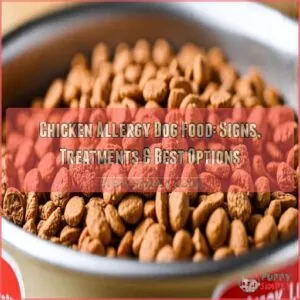This site is supported by our readers. We may earn a commission, at no cost to you, if you purchase through links.
 Curious to know if your pup can enjoy a bowl of jello? You’re not alone. Can dogs eat jello is one of the top questions pet owners have when it comes to feeding their furry friends treats.
Curious to know if your pup can enjoy a bowl of jello? You’re not alone. Can dogs eat jello is one of the top questions pet owners have when it comes to feeding their furry friends treats.
To answer this question, we must first take a look at what makes up jello – gelatin, sugar, artificial sweeteners and flavors along with colors for some varieties – then consider whether these ingredients are safe or toxic for our canine companions.
While there may be certain benefits from eating gelatin in small amounts like joint health improvement and digestive aid support as well as brain protection; too much sugar and other artificial additives can lead to serious medical problems such as poisoning in dogs.
So it’s important that pet owners understand the risks before giving any type of jelly treat including homemade dog treats made with gelatin powder or store-bought brands which specifically designed for pets.
Table Of Contents
- Key Takeaways
- Is Jello Safe for Dogs?
- The Components of Jello
- Signs of Jello Poisoning in Dogs
- The Benefits of Gelatin for Dogs
- Homemade Gelatin Dog Treats
- Guidelines for Giving Gelatin to Dogs
- Safe Gelatin Brands for Dogs
- What Jello Variants to Avoid
- What to Do if Your Dog Eats Jello
- Other Homemade Dog Treat Recipes
- Conclusion
Key Takeaways
- Jello contains unsafe components for dogs, such as gelatin, sugar, artificial sweeteners, flavors, and colors.
- Xylitol in sugar-free jellos is toxic to dogs and can cause poisoning.
- Homemade gelatin treats with real fruits/veggies are safer alternatives to jello.
- Plain unflavored gelatin from safe brands like Great Lakes Gelatin or Knox Gelatin is preferred over flavored jello.
Is Jello Safe for Dogs?
You may wonder if that sugary sweet treat is safe for your furry friend, but jello isn’t recommended due to its unhealthy ingredients. Jello contains artificial flavors, colors, sugars, and sometimes artificial sweeteners like aspartame or sucralose, which can cause weight gain in dogs and even lead to more serious health issues when consumed regularly.
Furthermore, xylitol found in some sugar-free jellos is extremely toxic for pets.
To keep your canine buddy healthy, consider providing alternatives such as unflavored gelatin treats with real fruits or vegetables mixed into the recipe. For example, you can make banana lemon gummies or pumpkin spice snacks using fish gelatin powder instead of cow hide collagen.
Also, look out for brands like Great Lakes Gelatin that offer premium gelatine proteins specifically designed with canine dietary restrictions in mind!
The Components of Jello
Jello is a popular dessert made from gelatin, sugar, artificial sweeteners, and various artificial flavors and colors. Gelatin is derived from animal collagen, often sourced from cow or pig hides and bones, while the other components are lab-produced products with questionable health impacts.
Therefore, it’s important to understand what jello contains before feeding it to your dog.
Gelatin in Jello
Gelatin is the main component of jello, derived from animal collagen and offering limited nutritional value to your pet. It is produced through a process involving boiling down bones or hides. Gelatin can also be found in foods like gummy bears and marshmallows.
Alternatives to gelatin include plant-based options such as agar agar powder for dogs who cannot have traditional gelatin sources.
When given in moderation, gelatin offers joint health benefits since it contains amino acids that help rebuild connective tissues. However, due to its low nutritional content, homemade treats with conscious ingredients are preferred over store-bought jello pudding products, which often contain artificial flavors and sugars.
Sugar in Jello
Sugar is one of the main ingredients in Jello, with over 19 grams per serving – that’s nearly five teaspoons! Jello alternatives include natural flavors and sugar-free options. Canine sugar intake should be limited; homemade dog treats are a healthier option to consider.
Gelatin benefits, such as joint health, may outweigh risks if given in moderation. Xylitol dangers are significant; always avoid products containing it or other toxic foods for dogs like high sugar content and artificial sweeteners.
Sugar substitutes offer an alternative to regular Jello, but caution is advised when introducing them into a canine diet.
Artificial Sweeteners in Jello
Be aware of artificial sweeteners, like aspartame and sucralose, often found in sugar-free Jello. Xylitol dangers can cause severe canine toxicity; sweetener risks should be considered for dog-friendly desserts.
Sugar substitutes, such as gelatin powder with chicken broth, make healthier homemade treats than using artificial sweeteners. Evaluate health risks before giving dogs any type of dessert or treat to ensure their safety.
Artificial Flavors and Colors in Jello
Surprise your pup with a treat, but be aware of the artificial flavors and colors that may lurk in Jello. Artificial additives like flavor enhancers and coloring agents can negatively impact pet health if ingested.
Instead, try natural alternatives or dog-friendly recipes for healthy treats free from artificial flavors and colors.
Signs of Jello Poisoning in Dogs
If your pup has eaten jello, be aware of the signs of xylitol poisoning, which may include an upset stomach, weakness, and seizures. Xylitol is a sweetener commonly found in flavored treats that can be extremely dangerous for dogs if consumed.
Symptoms of xylitol poisoning in dogs include vomiting, diarrhea, lethargy, and difficulty walking or standing up. Severe cases can even lead to seizures or coma with potentially fatal consequences. If you suspect your dog has ingested jello containing xylitol, seek immediate veterinary care as emergency action may need to be taken depending on how much was consumed and how long ago it happened.
There are also safe alternatives to using this harmful sugar substitute, such as honey or other natural sweeteners like maple syrup when making homemade gelatin-based treats for your canine companion instead! Be sure not only to take note of the potential adverse reactions associated with ingesting products containing certain artificial ingredients but also to make informed decisions about what types of flavored treats you give them so they stay healthy, happy pooches!
The Benefits of Gelatin for Dogs
Unflavored gelatin can provide a range of health benefits for your dog, including improved joint health, digestive aid, strengthening connective tissues, and even brain protection. Gelatin is rich in amino acids such as glycine and proline, which are known to play an important role in the development of healthy joints.
It also helps improve digestion by aiding with nutrient absorption while adding strength to your pup’s skin and coat due to its collagen content. Finally, some studies have shown that gelatin may be beneficial for cognitive functions as well.
Joint Health Improvement
You may be surprised to learn that adding unflavored gelatin to your dog’s diet can help improve joint health by up to 80%. Natural supplements like collagen and gelatin support canine flexibility, mobility, and reduce inflammation.
Homemade pet snacks with these ingredients are easy recipes for improved joint care.
- Improved digestion and gut health
- Joint repair and lubrication
- Increased energy levels and stamina
These natural remedies for pets offer a safe alternative without the risks of synthetic additives or drugs. Collagen supplements paired with proper nutrition provide complete wellness solutions for dogs of all ages!
Digestive Aid
Gelatin can help improve your pup’s digestion, so consider adding it to their diet for an extra boost. Gelatin treats are a great way of boosting canine wellness – they contain safe ingredients and provide digestive health benefits.
Capsules and homemade treats made with gelatin are also beneficial options that won’t cause harm to dogs when consumed in moderation.
Strengthening Connective Tissues
In addition to being a digestive aid, gelatin can also help strengthen a dog’s connective tissues. Studies have shown that it boosts collagen production by up to 25%, which is essential for healthy joints and skin.
The benefits of gelatin include improved flexibility, tissue health, and canine nutrition.
Brain Protection
By consuming unflavored gelatin, you can help protect your pup’s brain and keep their cognitive skills sharp. Gelatin benefits include neurological support for improved canine cognition, as well as protection against seizures.
It also helps to maintain a healthy level of brain chemicals like serotonin and dopamine – essential for enhanced mental alertness in dogs. With these beneficial properties, gelatin is an excellent addition to any dog-friendly dessert or nutritious treat! Pet owners should always consult with their animal healthcare provider before introducing new pet care tips or treats into the diet of furry family members.
Homemade Gelatin Dog Treats
Making homemade gelatin treats for your pup is a fun and tasty way to reward them with something nutritious. The basic base of the treat consists of cold and hot water, unflavored gelatin, as well as optional flavors like pumpkin spice, meaty gummy paws, banana lemon, or blueberry coconut that can be added in to make unique treats.
Basic Gelatin Treat Base
Making a basic gelatin treat for your pup is easy; just mix cold and hot water with unflavored gelatin and desired add-ins. Besides the gelatin benefits, there are many flavor variations you can use to make homemade treats.
Consider nutritional considerations when adding fruits, vegetables, or other ingredients like peanut butter. When giving dogs gelatin, dosage should be based on their weight: 10-25 lbs – 1/2 tsp twice daily; 25-50 lbs – 1 tsp twice daily; 50-75 lbs – 2 tsp twice daily; and 75+ lbs – 1 tbsp twice per day.
Prepare these treats in individual molds according to instructions provided by the manufacturer of the mold before chilling them overnight in the refrigerator.
Flavors for Gelatin Treats
Add a touch of deliciousness to your pup’s diet with fun and flavorful homemade gelatin treats! For a unique twist, try fruit combinations like apple-carrot or banana-lemon. Meat infusions such as bacon strips or turkey will appeal to the carnivore in them.
Herbal twists such as parsley, sage, and rosemary can also be added for extra flavor. Nut butter additions like peanut butter work great for picky eaters too! Vegetable mixes including sweet potatoes and carrots are not only nutritious but tasty too.
With all these ingredients at hand, you can have endless varieties of flavorsome jello treats that your pooch is sure to love! So why wait? Get creative in the kitchen today and surprise your furry companion with something special from you!
Guidelines for Giving Gelatin to Dogs
When it comes to feeding your dog gelatin, there are some important guidelines to follow. Gelatin can be beneficial for dogs in moderation, but you should always consult with a veterinarian before giving them any supplements or homemade treats.
The ideal dosage of gelatin depends on the size of your dog. Dogs weighing 10-25 lbs need 1/2 teaspoon twice per day. Dogs weighing 25-50 lbs require 1 teaspoon twice daily. Dogs weighing 50-75 lbs require 2 teaspoons two times each day.
Additionally, plain unflavored gelatin is best. Flavored jello often contains sugar and other unhealthy components like xylitol that can be toxic for dogs if ingested in large quantities.
For homemade treats using molds or ice trays, combine cold water with plain beef or fish collagen powder at a ratio of 1 cup warm liquid to 1 tablespoon powdered collagen. Then, add desired add-ins such as pumpkin spice mix or peanut butter. Chill the mixture until solidified in the fridge overnight.
This will provide more control over what ingredients go into it compared to store-bought forms, which may contain artificial flavors and preservatives lacking nutritional value for dogs.
Remember that too much supplementation of anything isn’t recommended, so monitor their intake closely when introducing new foods like these!
Safe Gelatin Brands for Dogs
Discover safe gelatin brands for your pup that can help support joint health, digestion, and brain protection. Gelatin’s amino acids promote canine collagen uses such as improved skin elasticity and coat shine.
Great Lakes Gelatin is a great option containing only grass-fed cowhide sourced from Argentina or Brazil.
Knox Gelatin contains pork-based collagen peptides with no additives like sugar or artificial colors.
Plain beef gelatin, extracted from cooked bones of animals before dehydration, provides an excellent source of protein.
Fish gelatins derived from wild-caught salmon offer essential fatty acids like omega 3s, along with minerals like calcium and magnesium.
Additionally, premium gelatin protein specifically designed for dogs should always be considered due to its easy dosage guidelines based on the pup’s weight – 1/2 teaspoon up to 2 tablespoons twice daily depending on size!
Avoid jello pudding high in xylitol or sugar content, as well as flavored jello with alcohol, at all costs.
What Jello Variants to Avoid
It is important to avoid certain jello variants, such as those with xylitol, sugar, artificial flavors, and colors. Xylitol is a common sweetener found in many store-bought jello products that can be toxic for dogs if ingested.
Artificial colors are also lab-produced and lack clear effects on canine health. Sugar-free varieties of jello contain alternative sweeteners like aspartame or sucralose, which may sometimes cause digestive issues in dogs when consumed in high amounts.
It’s best to prepare homemade treats using gelatin instead of buying store-bought versions that could potentially harm your pet due to the unhealthy components they might include. For instance, adding pumpkin spice flavorings combined with gelatin provides essential vitamins & minerals for digestion support.
Beef or fish gelatins offer joint protection & brain-boosting benefits without any risks associated with artificial ingredients used by manufacturers of commercial brands.
When preparing homemade treats, make sure not to use an excessive amount of sugar or salt. Instead, opt for healthier options like fresh fruit purees (banana/lemon) and shredded cooked chicken mixed into peanut butter along with vegetable broth.
What to Do if Your Dog Eats Jello
If your pup has eaten jello, it’s important to be aware of the potential health risks. If you suspect that your dog may have ingested xylitol or other artificial ingredients found in jello, seek immediate veterinary consultation.
It’s also important to recognize the signs of digestive upset and xylitol poisoning such as vomiting, diarrhea, weakness, and seizures in order to take preventive measures if necessary.
Unflavored gelatin is beneficial for pets when used cautiously. However, pet nutrition experts suggest a vet consultation before introducing any type of treat into their diet – especially for dogs on protein-restricted diets or with existing health issues like chicken liver disease.
These animals could react differently than others depending on their individual conditions.
For those who wish to offer treats regularly, try plain beef gelatin. It can help enhance joint health, aid digestion, and strengthen connective tissues while offering some brain protection too! Dissolve 1/2 teaspoon per 10-25lbs twice daily, up to 2 tablespoons twice daily for 75+ lbs dogs.
Other Homemade Dog Treat Recipes
Switching gears from the do’s and don’ts of jello consumption, let’s explore other homemade dog treat recipes.
A great place to start is with Peanut Butter Delights! These treats involve blending together peanut butter, plain unflavored gelatin, and water in a blender until completely mixed together.
For something on the healthier side that still packs a powerful punch of flavor, try Veggie Fruit Fusion. Simply mix up blanched vegetables like carrots and sweet potatoes, as well as some fruits such as blueberries, into bloomed gelatin with added human-grade ingredients like coconut oil or honey for sweetness without artificial preservatives or sugar-free additives found in store-bought treats.
Meaty Bites Extravaganza are perfect for any pup who loves meat-flavored snacks. Simply boil beef broth, then add chicken bullion powder before mixing it into bloomed gelatin along with cooked ground beef pieces sprinkled throughout each bite – yum!
Cheesy Veggie Bites make use of both cheese shreds and vegetable purees blended into bloomed gelatin, while Fruity Pup Pops combine frozen fruit chunks within cooled-down melted jelly, all topped off by rolled oats which give an extra crunchy texture when chilled – sure to be your furry friend’s favorite snack ever!
Conclusion
Your pup’s health should always be your priority, so it’s important to understand what your dog can and can’t eat. As enticing as it may be, jello is not suitable for dogs due to its unhealthy components.
Sugar, artificial sweeteners, and chemical additives can lead to numerous health problems in canines.
Fortunately, unflavored gelatin can be beneficial in moderation, especially when added to homemade treats. Premium Gelatin Protein for Dogs is an excellent alternative as it offers joint health improvement, digestion aid, and brain protection.
When creating homemade treats, stick to conscious ingredients like parsley, vegetables, fruits, or peanut butter, and use beef or vegetable broth.
Always be mindful that the guidelines for gelatin intake are based on your dog’s weight. Ingestion of xylitol requires immediate vet attention, so keep in mind what jello variants to avoid.
Can dogs eat jello? The answer is no, but your pup can enjoy the benefits of safe gelatin products in moderation.
















